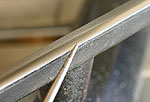This is a Veteran Owned site
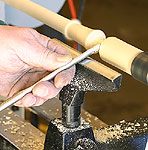 |
Paying attention to your tool rest will make life at the lathe more fun. Click image to enlarge |
Tool Rest Maintenance
Preventing hitches in your turning git-a-long
Text & Photos by Tom Hintz
The tool rest on your lathe does more than support turning chisels. It also serves as a guide that helps make smooth, consistent depth cuts when rounding or sizing a piece of wood. However, tool rests are made from relatively soft cast iron and eventually become nicked and scratched. Novice turners understandably experience more catches that can create deeper nicks in the tool rest.
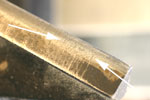 |
These nicks look small but but can easily make a turning tool hesitate or stop. Click image to enlarge |
Seemingly small indentations in the tool rest can make it difficult to slide a turning chisel along it smoothly. The resulting hesitations in the movement of the chisel often translate to unwanted changes in cut depth in the stock. A little maintenance will make your tool rest more user friendly and let you concentrate on making better cuts.
Smoothing the Surface
I use a fine machinists file for the initial smoothing of the tool rests surface. Begin with rocking strokes, following the surface from the front face of the rest to the rear edge. Adding a little left-to-right motion to these initial strokes will prevent creating low spots.
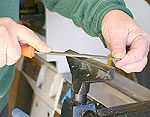 |
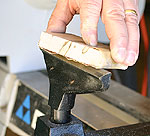 |
A fine machinists file (Left) removes the nicks and dings. (Right) Fine sandpaper on a block finishes smoothing the surface. Click images to enlarge |
|
As soon as the major nicks are removed, start running the file along the length of the rest, still rocking it front to back to maintain the curved surface. Usually a minute or two of filing will rid the surface of dents and nicks.
Remember to blunt the edge of the tool rest that is normally positioned next to the stock. This edge can be rather sharp as the rest comes from the factory and filing can sharpen it more. The last
thing we need is a slicing edge where a finger could get pinched if things go wrong. Run the file along that edge to blunt and round it slightly.
Wrap a piece of 220-grit paper around a block of wood and refine the surface a little more. Using the block rather than hand sanding helps keep the tool rest surface flat. All we are trying to do with the paper is knock down any scratches left by the file. The surface will not develop a shine but you will notice a satin-like appearance as the paper does its job.
Wipe the tool rest down with a rag or paper towel to remove any remaining grit left by filing or sanding.
Waxing the Tool Rest
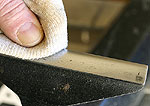 |
A very light coat of wax makes the tools slide along the rest easily. Click image to enlarge |
Rubbing a light coat of wax onto the tool rest surface does wonders for how easily turning chisels slide across it. Because there is no absorption, very little wax is needed. I keep a rag used for "burning in" wax-based finishes on my projects handy. Rubbing the surface of the tool rest briskly for several seconds with one of the spots of hardened wax is all it takes. Any wax used in woodworking will work.
After using wax on tool rests for a while you will recognize the feel when the wax is wearing off. A few quick rubs with the wax-carrying rag will restore the slick feeling.
Sharp Tool Shafts
 |
Grinding a small radius along the edge of square tool shafts helps them slide easily and they do less damage to the rest. Click image to enlarge |
Some turning tools have crisp, sharp edges along their shafts that nick and gouge the tool rest easily. That sharp edge will also catch very easily in even small nicks and scratches.
I grind a small radius along the edges of all my square tool shafts. The shaft need not be rounded; just replacing the sharp edge with a small rounding helps immensely.
Whether you are a novice or veteran at the lathe, keeping your tool rest smooth will make controlling turning chisels easier and more predictable. For the novice turner, this bit of maintenance can be especially important as it allows concentrating on developing good tool technique without the distraction of them catching on the rest.
Do you have a comment on this story? - Email Me!
All written, photographic and drawn materials are property of and copyright by NewWoodworker.com LLC 2000-2019. Materials may not be used in any way without the written permission of the owner.

